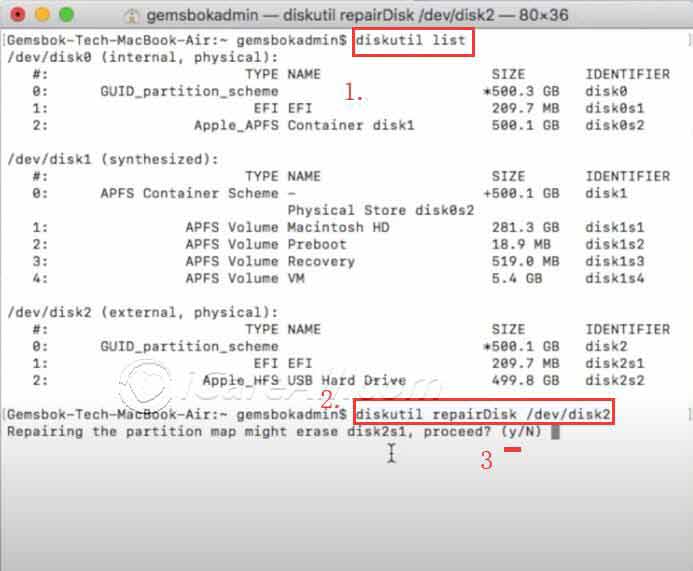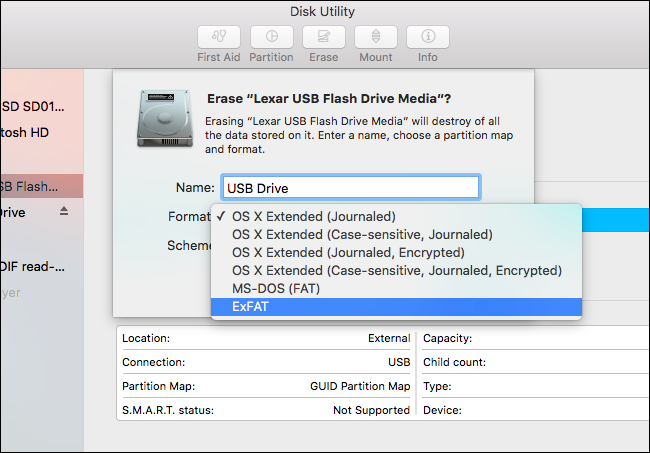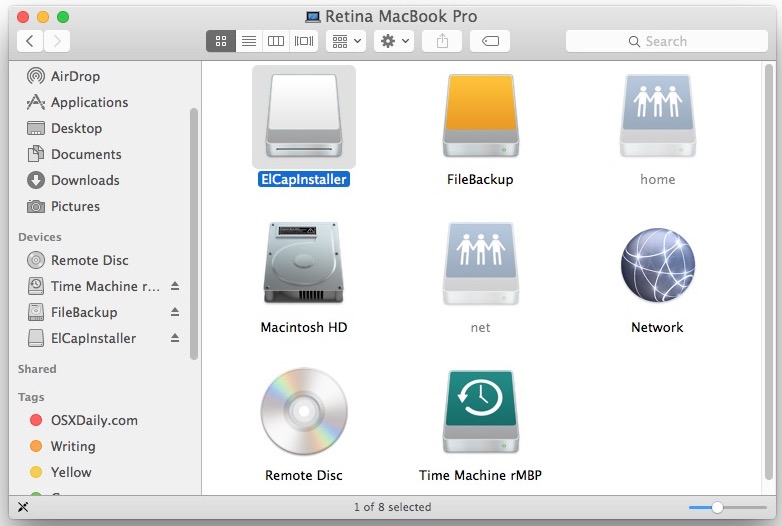Formatting in context of USB or Hard Drives means deleting everything from that drive and rebuilding the file system so that we can use it with an Operating System. And we usually perform formatting in our USB or External Hard Drive when we want to get rid of viruses, or we want to clean the disk as it was when we purchased it. Also when we buy a new USB or Hard Drive, it often comes with windows compatible not the mac so formatting it even needed in this case. So in this post, I will tell you “How to Format USB on Mac?”.
How to Format USB on MAC?
If you never formatted a USB drive then don’t worry it is effortless. And here I will tell you two answers to this question that “How to Format USB on Mac?”. First, we will go with the straightforward way of doing it; then we will move to the easy way. 😉
So first, we will use the Disk Utility program, which is a GUI and very straightforward so that any kid can do it. Then in the next method, we will format USB drive from mac terminal. So let’s start.
Format USB on Mac using Disk Utility
So in this example we will reformat the actual disk, disk2 using the command: diskutil eraseDisk JHFS+ BackupMaster disk2. Here the command diskutil eraseDisk does the erasing, format is expressed as JHFS+ which is the Mac OS Extended (Journaled) and disk is named BackupMaster and the actual target disk is defined by its identifier disk2. In this tutorial, we explain how you can format a hard drive using the command prompt. Before proceeding further, make sure you backup all available data to prevent data loss. To format the flash drive in Linux, we need to unmount it first. To do this, you have to enter the 'unmount' command, following by the identifier. In our case, we will enter the command: $ sudo umount /dev/sdc1. Step 4: Format the USB drive. Now, you can just format the USB drive in Linux by entering the 'mkfs' command. It will have a parameter.
- Connect the USB Drive to your Mac. (This is obvious we need a USB first, then only we can format it 😛 )
- Now we need to open Disk Utility. (Here I will give you one more tip. To open any program in your Mac just press the command + spacebar. It will start the Spotlight Search, now from here you can search for any program, but now we need Disk Utility, so search it).
- Now, on the Disk Utility window you will see External Drives on the left.
- Here I have my USB Drive connected, and its name is No Name. In the top we have options like First Aid, Partition, Erase, Restore, Unmount. To format the drive we need to click on the Erase Button.
Format USB on Mac
- Here, we have two options, the first one is the Name that you can set for your USB Drive. The second one is the Format. If you want to make it windows compatible you need to select MS-DOS (FAT) here. And you can also use the Mac OS Format. So its up to you what you want.
- Now, just click on the Erase Button to complete the format.
- And thats it. Your drive is formatted.
For formatting any External Hard Drive, we can follow the same steps.
Format USB Drive Mac using Terminal
We also have a Command Line Disk Utility interface in Mac. And we can use it to format the USB on Mac as well. Now lets see how we do this.
- First open the terminal (Again press command + space, write terminal and hit enter).
- In terminal now type the following command.
- The above command will display all the disk connected with your machine.
- Here the USB Drive that is connected, is disk2 and we will format this disk only. To format the USB drive here we will write the following command.
- In the above command eraseDisk is the format command. Then comes JHFS+ is the Disk Type which is Mac OS Extended (Journaled). Then Belal is the name of the disk that will be assigned after formatting. Finally we are writing the name of the disk that we need to format, which disk2 is in this case. Now hit enter.
- And the disk is formatted. 😉 Super Easy, isn’t it?
So that’s it for this tutorial friends if you got some problems then tell me in the comments. And if you think this post was useful for you, or it helped you in any way, then I request you to please SHARE it with your friends. I hope you got the answer very clearly that “How to Format USB on Mac?”. So thank you, guys. Will catch you in the next post.
Summary :

When you get a new USB drive and want to format it, you may wonder: what is the best format for USB drive? Well, the best format for USB drive is different for different operating systems and devices. This article will show you how to choose the best format for USB flash drive.
Apply a paragraph style in Pages on Mac Using paragraph styles is a quick way to uniformly format text throughout a document. Apply a paragraph style Select one or more paragraphs, or click anywhere in a paragraph to apply the style to only that paragraph. Mac os x iso. Intro to paragraph styles in Pages on Mac A paragraph style is a set of attributes—like a font size and color—that determines how the text in a paragraph looks. You can use paragraph styles in. Set line and paragraph spacing in Pages on Mac You can increase or decrease the spacing between lines of text, and change the amount of space before or after a paragraph.
Quick Navigation :
Nowadays, USB flash drive is widely used on various electronic devices due to its portability. Before you use a new USB drive, you need to first format it. Well, what is the best format for USB drive? How to choose the best format for USB drive?
Before you try to choose the best format for your USB drive, you need to know what file system it is in.
What Is File System?

What is file system?
In computing, a file system or filesystem controls how data is stored and retrieved. With a file system, the information placed in a storage medium will be separated into pieces and each piece will have a name, so the information is easily isolated and identified this way. Each group of data is called a file.
File system is the structure and logic rules used to manage groups of information.
File systems can be used on a numerous variety of storage devices and media types. There are many different types of file systems; each of them has different storage devices that they are the most suitable for.
What is the best format for USB drive? Well, it depends on how you plan to use your USB drive.
How to Choose the Best Format for USB drive
Basically, to choose the best format for USB flash drive. The two most important things you need to consider are the operating systems you plan to use it with and the sizes of the files that you are most likely to transfer and store.
The following contents list some commonly used file systems. To better understand which one is the best file system for USB drive according to your needs, you can view the compatibility, pros and cons of these file systems one by one.
When you get a new USB drive, you can follow this guide to choose the best thumb drive file system for your portable drive.
NTFS vs HFS+ vs FAT32 vs exFAT vs Ext 2,3,4
1. NTFS: The New Technology File System (NTFS), a proprietary journaling file system developed by Microsoft, is the default file system of the Windows NT family.
- Compatibility: Windows XP/7/8/10, Linux (read-only for some distributions), MacOS(read-only), Xbox One
- Pros: journaling, no realistic file size limitations; support for file compression, high security
- Cons: can be read-only for Mac OS, or be written by Mac with the help of third-party software
2. HFS+: The Hierarchical File System (HFS+) is the file system modern MacOS versions use by default. If you want to use your USB drive on Mac devices, you can format USB to HFS+.
- Compatibility: MacOS, Linux(readonly), Xbox 360/One
- Pros: journaling, encrypt or compress files or folders
- Cons: cannot be read by the Window unless using third-party software
3. FAT32: The File Allocation Table 32 (FAT32) was the standard Windows file system before NTFS. And it is widely recognized by almost all operating systems. Most portable devices also support FAT32.
- Compatibility: Windows, Mac, Linux, Chrome OS, Android, Chrome OS, Android, Xbox 360/One, PS3, PS4, printers, projectors…
- Pros: compatible with almost all versions of Windows, Mac, Linux and practically any device with a USB port
- Cons: cannot store a single file which is larger than 4GB; cannot create a FAT32 partition that is larger than 8 TB (Windows only recognizes 2TB)
4. exFAT: The extended File Allocation Table (exFAT) is similar to FAT32, but does not have the limits of FAT32 file system. It can be used where NTFS is not a feasible solution, but a greater file-size limit than the standard FAT32 file system is required.
- Compatibility: Windows, Mac OSX 10.6.5 and above, PlayStation 4 (with MBR, not GUID), Xbox One, Android
- Pros: good for larger file sizes and drives, compatible with both Windows and Mac OS
- Cons: Microsoft restricts its usage by license obligations.
5. Ext 2/3/4: The extended file system (Ext) was the first file system created specifically for Linux. If you plan to use the USB drive on Linux computers, you can format it to this file system.
- Compatibility: Linux, Xbox 360/One
- Pros: support for large file sizes and large drives
- Cons: cannot be read and written by Windows unless with third-party software, Ext 2 lacks journaling.
After the comparison, have you picked your best format for USB drive?
All in all, FAT32 is actually compatible for the most types of systems. It’s practically compatible with any device with a USB port, while NTFS and exFAT are not so much. HFS+ is specially used on MacOS, and Ext 2, 3, 4 file systems are created by Linux.
FAT32 - The Best Format for USB Drive
As you can see from above, FAT32 is supported on almost all devices, which makes it the choice of file system format selected by the most people for USB drive.
As long as you don't use it to transfer a single file larger than 4 GB, FAT32 is perfect and can be the best portable file system for USB drive due to its compatibility.
So we draw the conclusion that although FAT32 has its limits, it’s the best file system to use for most portable drives like USB drive, SD card, etc. Besides, most USB drives have small capacity because they are hardly ever used as the main data storage. Therefore, they will not be used to store large files. The limit will not affect you too much.
How to Format USB Drive in Windows or Mac
After choosing the best format for USB drive according to your needs, you might start to wonder: how do I format USB drive to NTFS/FAT32/exFAT/EXT 2,3,4/HFS+ in Windows operating system or Mac? Well, don't worry. if you need to format USB drive to NTFS/FAT32/exFAT/EXT 2,3,4/HFS+ file system, please follow the steps as below.

Well then, how to format USB drive to FAT32/NTFS/exFAT/EXT 2,3,4/HFS+ if you have the need. Don't worry, the following part will show you the solution for Windows and Mac OS users.
The process for formatting a drive is different depending on the system you’re using. Let’s see how to format USB drive on a Windows PC first.
Format USB drive on Windows Operating System
To format USB drive in Windows operating system, it is recommended to use the free USB formatter MiniTool Partition Wizard Free Edition.
MiniTool Partition Wizard Free Edition is a free partition manager & USB formatter. It can help you resize partition, extend partition, format partition, convert FAT32 to NTFS, check file system, copy partition, migrate OS to HD/SSD and so on. As a free partition manager, it is equipped with many advanced features that cannot be found in Disk Management.
With its user-friendly interface, this free partition manager is worth trying.
First, you need to connect the USB drive to your Windows PC. Then you can follow the steps as below to format USB drive for Mac and Windows on a Windows PC.
Step 1. Download MiniTool Partition Wizard Free Edition by clicking the following button. Install and launch it to get its main interface.
Step 2. Right-click the drive you want to format and select Format Partition from the left action panel.
Step 3. At this page, specify the partition label, file system as well as cluster size. The cluster size is set by default.
Step 4. After resetting these parameters, you can click OK.
Step 5. Click Apply button on the upper left corner to allow the pending operations.
If you need to format USB drive to FAT32/NTFS/exFAT/Ext2/Ext3/Ext4, MiniTool Partition Wizard Free Edition can be your best USB formatter. You can also change your USB format with this tool at ease. Try it now!
Format USB Drive in Mac
If you want to use the USB drive on your Mac computer only, formatting it to be entirely Mac compatible file system is highly recommended, such as HFS+ file system. If you want to use the drive between a Windows and Mac machine, you can format it to FAT32.
You can follow the steps as below to format USB drive to HFS+ or FAT32 in Mac. Here I will format the drive to FAT32 for demonstration.
Step 1. Connect the USB flash drive to your Mac computer.
Step 2. Go to Applications and then click Utilities.
Step 3, Double click Disk Utility to open it.
Step 4. Select your USB flash drive on the sidebar, choose Erase.
Step 5. Name the USB drive, choose the MS-DOS (FAT) for Format, Master Boot Record for Scheme. Then click Erase.
Format Thumb Drive Mac Command Line Command
Step 6. When it is finished, your USB drive will be formatted to FAT32 as the file system.
Wrapping Things Up


If you don't know how to choose the best format for USB drive, this article could be a big help. If you don't know how to format USB drive to the best file system, this article can also resolve this issue for you.
Format External Hard Drive Mac
If you have a different opinion about the best format for USB drive, please don't hesitate to share it with us. If you need any help formatting USB drive in Windows, you may leave it in the following comment zone. And we will reply you as soon as possible. You may also contact us via [email protected] if you need help.

